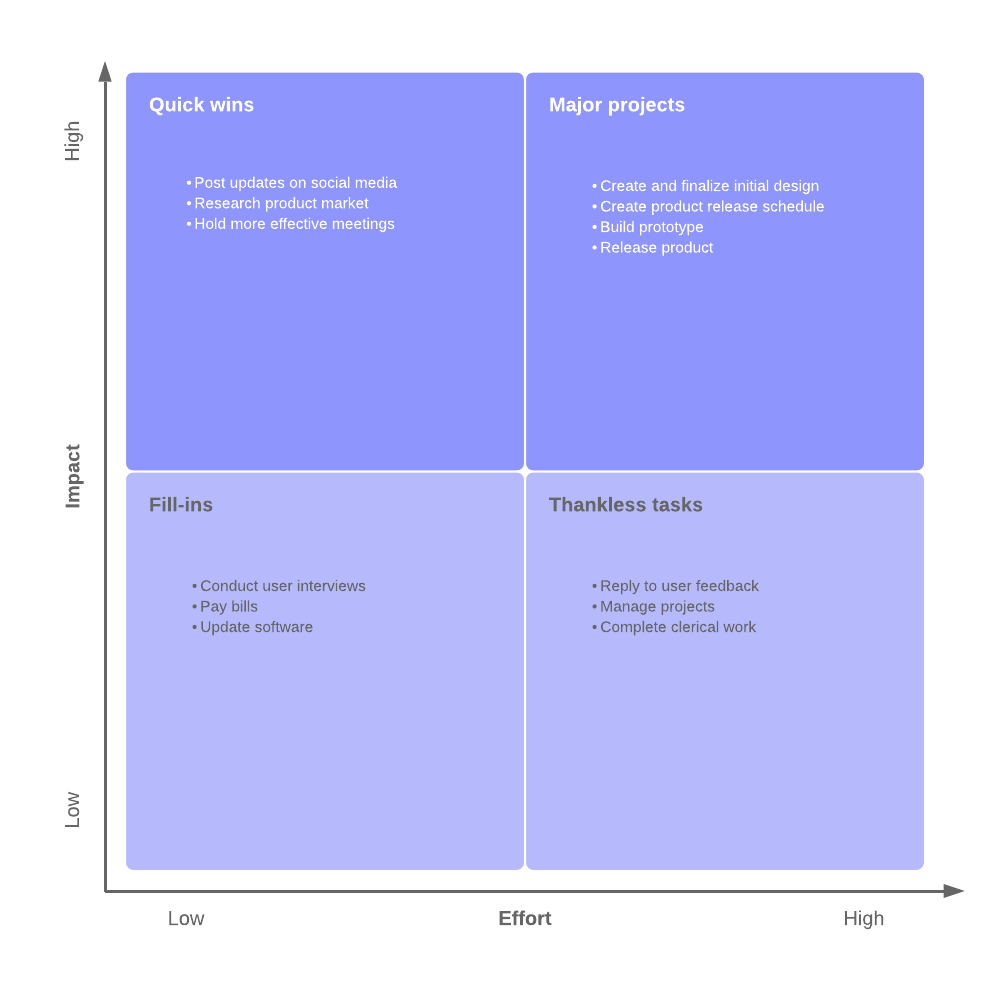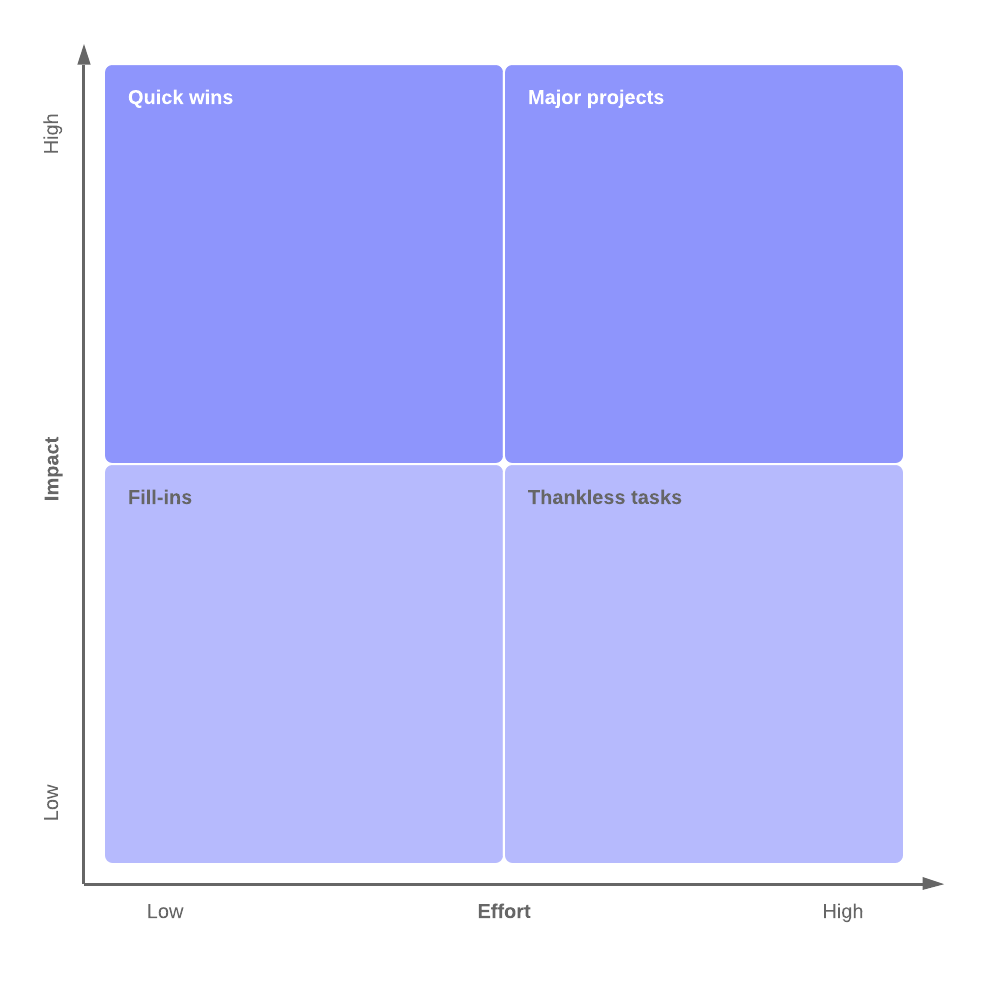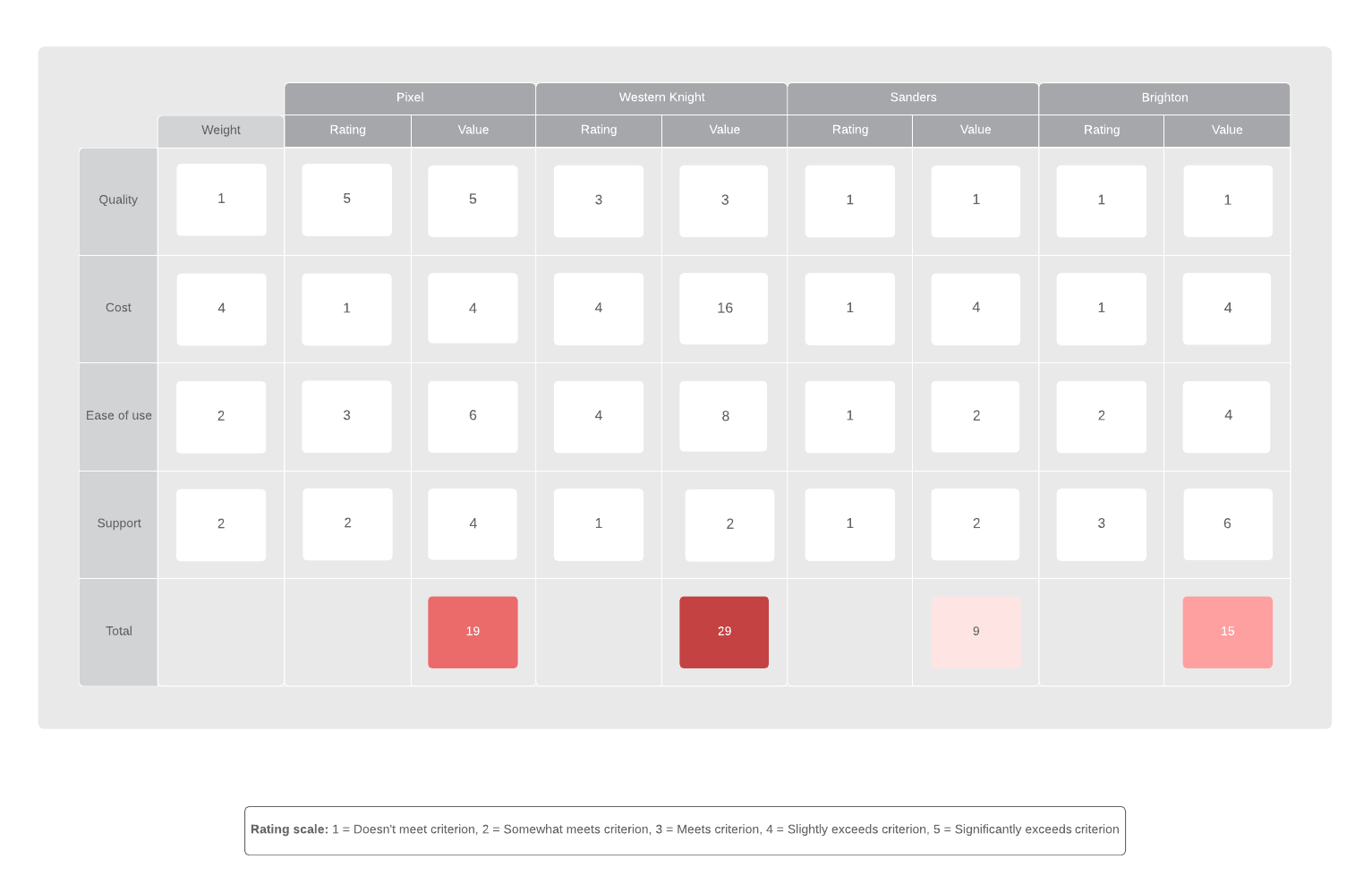Get your priorities straight: How the priority matrix can help you focus on what matters most
Lucid Content
Reading time: about 6 min
The mark of any successful endeavor is built on not only excellent ideas, but excellent execution. It’s not enough to have a great concept, a great team, and great tools. To achieve success and outpace your competition, your execution needs to be top notch. Setting goals and meeting deadlines will help your company build both steady growth and a reliable reputation with consumers, partners, and stakeholders.
Execution, while simple in theory, requires a disciplined mindset that may not come easily to all but can be learned. One of the most important aspects of execution is prioritization—knowing what to work on, when to work on it, and when to put it aside for something more pressing.
Prioritization is based on a variety of factors: time sensitivity, importance, monetary or energetic cost, necessity to a subsequent task, etc. One of the most important tools to help you weigh these factors and determine which tasks and projects to complete first is a priority matrix.
With a clear way of charting out priorities, this model can help your productivity and execution can go from efficient to extraordinary. In this article, we’ll define what a priority matrix is, why it works, and how to implement it in your business.

What is a priority matrix?
A priority matrix is a powerful time and project management tool that can help you focus on what matters most and keep critical projects on track. Based on the four time management quadrants developed by notable business leader Stephen Covey, this prioritization matrix breaks tasks out into two dimensions: urgency and importance, impact and effort.
This matrix is very similar in structure and practice to the Eisenhower matrix, which is very useful to manage personal tasks and prioritize time wisely. However, priority matrix project management is geared more toward project and operations managers who need to manage larger initiatives and teams and make production schedules more efficient to maximize on ROI.
Let’s break down each quadrant of the matrix.
Quadrant 1: Quick wins (High impact, low effort)
Type of project: High-value tasks and unforeseen or procrastinated projects. Tasks that fall in this quadrant are both critical and urgent to complete.
Approach: Do these tasks first.
Quadrant 2: Major projects (High impact, high effort)
Type of project: High-value tasks without clear, firm deadlines. These tasks will move the needle, but as they aren’t time-sensitive, they are often neglected or deprioritized.
Approach: Set deadlines and build checkpoints into your schedule.
Quadrant 3: Fill-ins (Low impact, low effort)
Type of project: Less important tasks with loose deadlines. These are filler tasks that can be easily deprioritized or delegated.
Approach: Delegate or decline these tasks.
Quadrant 4: Thankless tasks (Low impact, high effort)
Type of project: These are time-consuming tasks with little impact on business ROI. Whenever possible, try to avoid adding these tasks to your schedule so they don’t distract from more high-value work.
Approach: Do these tasks later, or try to eliminate them entirely.
Ideally, your project schedule will be full of “quick win” tasks. But most project and operation managers will need to juggle tasks in each section of the quadrant. However, with a clear understanding of how to prioritize each type of tasks, you can make the most of your time and opportunities.

The science behind why the priority matrix works
No matter how engaged, invested, and detail-oriented you may be, it’s impossible to execute every task with the same level of attention—it’s also not necessary.
Setting a priority list or mapping out a priority chart takes advantage of your brain’s hard wiring ability to focus on the most important tasks at hand. Psychologists call this selective attention—the brain’s natural tendency of filtering out unnecessary information, as it is constantly taking in and working through information.
Cognitive scientists categorize selective attention into two forms: bottom-up and top-down. Bottom-up focus is reactionary: It happens when something disrupts your thought process and steals your focus. A barking dog, a loud bang, a frantic thought, a phone notification—instances when you can’t help but pay attention are labeled as bottom-up.
The selective attention that leads to top-rate execution, however, is labeled as top-down: When you’re able to see the broader picture and choose one task to focus on at a time, it’s considered top-down or “voluntary” focus. This type of focus is goal-oriented and creates brain functioning that is based on prior experience current conditions.
Research suggests that multitasking is a myth, and what we call multitasking is rather our brains oscillating from one thing to another very quickly. The switching back and forth uses extra energy that experts say should be dedicated to the most important tasks in your work and life. Further, the less important you consider a task to be, the less focus your brain attributes to it, making distraction easy and accidental.
Think about a scenario that you consider to be low effort and low impact, like doing five extra cold calls for a low-selling product or service offering, versus pitching a project that you’ve been working on for a year to your company’s CEO. Which task is more likely to be accompanied by distractions?
It’s important to monitor the work you do, the type of focus you attribute to it, how often and for how long you become distracted, and also how important the task is. Having a well-defined priority map will capitalize on your brain’s natural cognitive processes and add a turbo boost to your brain power by giving you a more efficient ROI on your limited attention.
How to make a priority matrix
Once you understand how and why the priority matrix works, you’ll be able to effectively put it into action. With any new strategy or tool, it’s important to know exactly how to use it to maximize its effectiveness and impact.
To get started using a priority matrix, follow these key steps:
-
Make a list: Log all of your current projects, goals, and priorities—whether they are daily tasks, ongoing projects, or larger strategic initiatives.
-
Rank each item: On a scale of 1-10, rank each task by its impact on the business. Use the same scale to measure each item on your list by level of effort required.
-
Map it out: With this weighting in place, you’ll be able to strategically plot your activities into appropriate quadrants on the matrix and prioritize, delegate, or deprioritize accordingly.

Better project prioritization with Lucidchart
Whether managing a large company of 100+ employees or tackling a group of projects all by yourself, a priority matrix is a great and useful tool for project management. Once it’s decided which projects you’ll take on, begin right away at implementing additional tools to accelerate your execution and help you visualize your process.
Lucidchart offers a variety of visual aids and project management tools like Scrum boards, Gantt charts, timelines, and product roadmaps, giving you the ability to control and monitor your progress. With industry standard project mapping software and versatile shareability, Lucidchart users are able to keep tasks on track by sharing with teammates and stakeholders across multiple platforms. Streamline your execution and try Lucidchart free today.

Don't stop there—see how else Lucidchart can help you manage your time better.
Read nowAbout Lucidchart
Lucidchart, a cloud-based intelligent diagramming application, is a core component of Lucid Software's Visual Collaboration Suite. This intuitive, cloud-based solution empowers teams to collaborate in real-time to build flowcharts, mockups, UML diagrams, customer journey maps, and more. Lucidchart propels teams forward to build the future faster. Lucid is proud to serve top businesses around the world, including customers such as Google, GE, and NBC Universal, and 99% of the Fortune 500. Lucid partners with industry leaders, including Google, Atlassian, and Microsoft. Since its founding, Lucid has received numerous awards for its products, business, and workplace culture. For more information, visit lucidchart.com.
